A few days back people’s architect was making headlines. The headline read – “Architect Hafeez Contractor offers to design 19 railway stations for free”. The headline and the content started a debate among a lot of architects. The headlines had an effect in our office as well, more negative than positive. I, on the other hand couldn’t understand bashing of Architect Hafeez Contractor (AHC), by people and also in an open letter by Mr. Shubhayan Modak, on the pro-bono work his firm had taken up. As Mr. Modak had decided be a ‘collective voice’ of a lot of people, I will be taking his argument and talking on it layer by layer.Journalism, Media and the Mighty pen warriors are usually the ones who have the burden of bringing facts to light. Transparency and scrutiny is what I expect from them. However, the state of Indian journalism has been hitting the lowest of lows in today’s time. Media has become biased. In place of fact hunting, they aim at making their audience emotional. I am son of a journalist, I have seen my father and his friends work. They can find a needle from a haystack. Their dedication has made them who they are today. However, when the kinds of Mr. Shubhayan Modak take advantage of this title, I feel bad for the entire journalist fraternity. I wish Mr. Modak had more experience in the field. I wish, in place of sipping a warm cup of tea and scrolling through Facebook, he had ‘researched’ before writing an open letter.
Before I begun, I must equip you with some background information which is vital. Indian Railway Station Development Corporation (IRSDC), which comes under Indian Railway (IR), had publically invited architects in helping itself to develop 600+ railway stations across the country. As per their brief this will be world’s largest Transit Oriented Development (TOD) program. The invitation, all related briefs, names/location of railway stations and other required details can be obtained from irsdc’s website. The IRSDC had requested “…for contribution from experienced architect/planners/engineers (The “Applicant”) on honorary basis (on no cost basis) to prepare concept master plan…”
Having brought the ‘Client’ and their ‘needs’ in the picture, let me now talk of the public reaction, reaction by Mr. Modak, and reaction of many others like him, that I didn’t understand. I will use snaps of His open letter for this purpose.
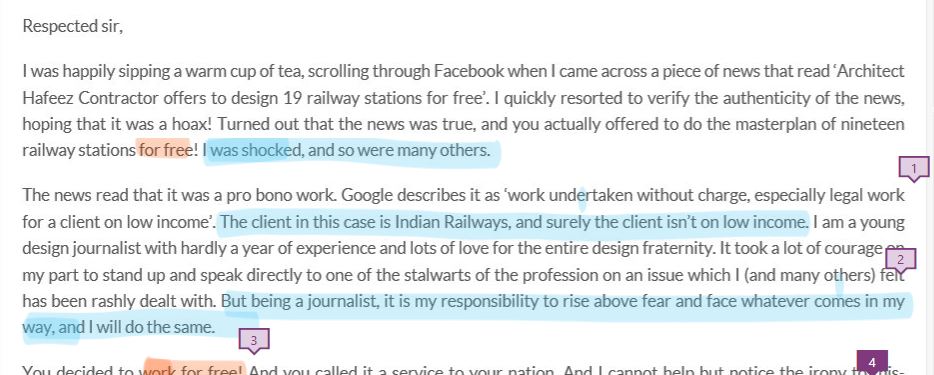
As Mr. Modak writes, his Google search describes ‘pro-bono’ work to be “work undertaken without charge, especially legal work for a client on low income”, whereas My Wordweb dictionary describes it as “work done for the public good without compensation”. A dictionary faceoff isn’t my aim, but he being a journalist shouldn’t rely on convenience brought to him by google alone.
If he does rely on google, he should have searched for finances of the Indian Railways as well. As per Economic Times, Indian railway suffers huge losses in passenger sector every year. The figures can be found online on their website, they are in thousands of crores. As per a railway staffer the IR has to invest in Rs.110 to earn Rs.100, i.e. the passenger sector is in a loss (The same sector for which 600+ railway stations needs to be developed). We cannot ignore the fact that a limb of the government is poisoned. His statement isn’t the reality, and that is the first disagreement I have with his argument. To assume the IR can manage with the given situation (If not, then the taxpayers pay!). IR may not be on low income, it certainly is stripped of money. Unfortunate, but a reality.
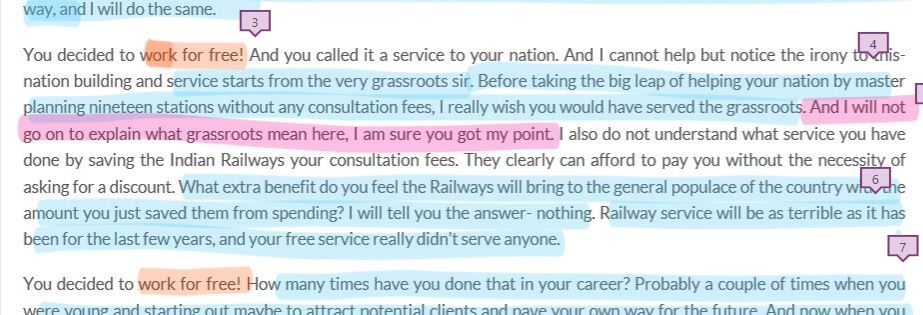
“You decided to work for free”, the term is ‘pro-bono’, which is being missed. The Media and the author of this open letter has used the word ‘free’ again and again, the headlines was made by the PTI and then later blindly copied by other news sources (a copy-paste job). My question, – why should AHC face the brunt of words, which the media has put in his mouth?
Moving forward, the author talks about ‘grass-root’ service. Everyone has their own definition of ‘building the nation’, everyone has their share and manner of contribution. His definition of nation building may be ‘grass-root’ service but should it necessarily be everyone’s? And what is this ‘grass root’ service? Does he assume everyone (or at least the architect in question (as if it were a personal connotation between the two?)) knows what his definition of ‘grass-root service’ is? , “…you got my point…” ? I don’t know what he means! However, if someone decides to help the nation by providing service expertise of the field he is from, does it become any less? I will help people with my best resources. I will try to help them in their affected realm. If someone wants water, if I have the resources, I will provide them water. I will not broom the floor they stand, and ask for water, on.
The Article later claims that AHC’s service will be a waste, as the terrible management of railways will never improve. A very sadistic perspective. The point here however is different. IRSDC is the client, they make railway stations. They wanted help in planning and not management. AHC isn’t a management firm. Will AHC’s service be a waste depends on a lot of factor- Like them qualifying this competition first!

A lot of architects do work for funny fees or free in their early stages of life, being backed with a lot of secondary sources of income, it doesn’t matter to most. Getting a grip in the market is their priority. True, however, calling such an act ‘a public stunt and gimmick’ is wrong. I will tell you why, PTI’s article was based on the words of Mr. Sanjeev Kumar Lohia, Managing Director and Chief Executive officer of IRSDC. “We had an open invitation for professionals to work pro-bono for developing concepts and master plans for redevelopment of stations. Hafeez Contractor has shown an interest in 19 stations,” These are the statement give to PTI, not by AHC, but by MD and CEO of IRSDC. So when people, out of impulse avoid reading the entire content of a news, they end up assuming a lot of things. Mr. Shubhayan Modak, a so called journalist, couldn’t read a news by PTI (PRESS TRUST OF INDIA)? If so, then shame on him! This is lousy journalism!

A questions of who actually will work for free, The chief architect or his subordinates, comes into the picture. The idea of who will work for free, or how does a firm manage its human resources is none of my business, it is their internal management. Why is he worried about their pay cheque? If at all then it should be the employees of AHC asking their boss and not us. Who is anyone, not part of the firm, to question this? A wrong argument. It is not professional to question on how anyone manages their profession. For example, if Mr. Modak spends his time sipping a warm cup of tea while browsing facebook, then when does he get time to do a detailed research? Who am I to ask this question to him? “…you got my point…” ?

Come the sixth paragraph, Mr. Modak talks of consequences to him, if his firm’s work is lousy. I am excited to see his warnings. He says he has a year of experience, yet he has the audacity to almost threat a firm practicing from years in the country. ‘Free’dom of speech. Or maybe I am wrong. Let me twist perspective and rearrange my words, He has the kind intentions to warn a person with a Padman Bhushan, a national awardee, that he will face consequences if his firm does a lousy work. It is one thing to disagree, another to sternly talk of negative consequences. He even challenges him by saying “…can you afford to offer complete design, sanction, approval…” Now, as far as the question of “…what next…” is concerned, people need to read the detailed brief on IRSDC’s website. It has answers to what ‘next’ and all that follows (lousy journalism Mr. Modak!).
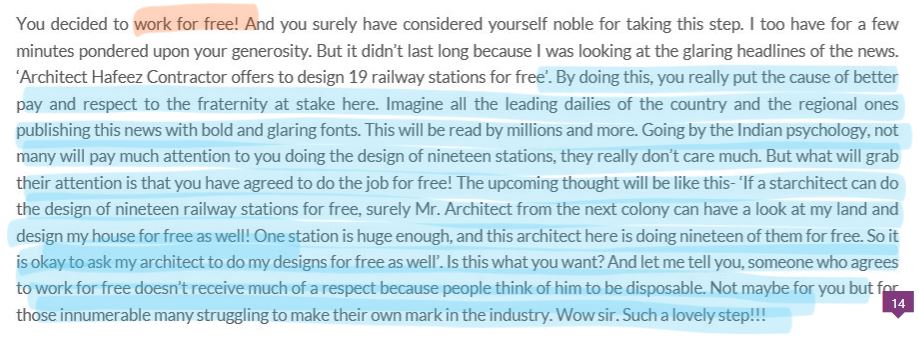
In his open letter, something which irritated me the most was his obsession with “work for free!” More than AHC I think the media has given AHC publicity it didn’t deserve. Mr. Modak couldn’t figure out who had called the press. Anyway finally we have something solid to talk about. Mr. Modak now talks of the Indian mentality w.r.t to the headlines. Yes, the Indian Mentality is skewed to take people for granted. ‘Free’ becomes disposable. I agree. However, dealing with the client is an architect’s job. If your client isn’t ready to pay you, or demands freebies, then one needs to grow the courage to deal with them! (In place of writing personal open letters, asking others to behave in a certain manner). Having said that, I’ll still give this one to you. A valid concern.
Secondly, I will not put the burden of the whole fraternity on one architect. The fraternity is very big and actions of one architect doesn’t let it down (or is AHC so powerful that he can?). On the other hand it will be a shame if architects didn’t join in to help the very country they are running their businesses in. There are 600+ stations to be (re)developed and AHC could only take up 19 of them, a big leap for the fraternity. At the time the news made headlines, PTI reported that at least 4 architects had taken up the offer. After the news, there were at least 30 Architects who had taken this competition up! So now we have at least 30 Architects who will ahem,“… work for free!” Remember, PTI was called by the client and not AHC.
Thirdly, an example- when ISRO had successfully launched the Mangalyan, the international fraternity was slamming India with similar accusations. India is home to homeless people, people who have no access to toilets and also hungry people, yet we launched a satellite to Mars. Shouldn’t have we used that money to deal with those problems? Unfortunately our society has disparity. It doesn’t mean that we pull back those who have become capable of doing charity on their own. We are not crabs in a cage. We should not question, those who achieve, by showing them the sorry states of others. What kind of country are we in, if we discourage the resourceful from doing something out of the fear of society? ‘What will people say?’
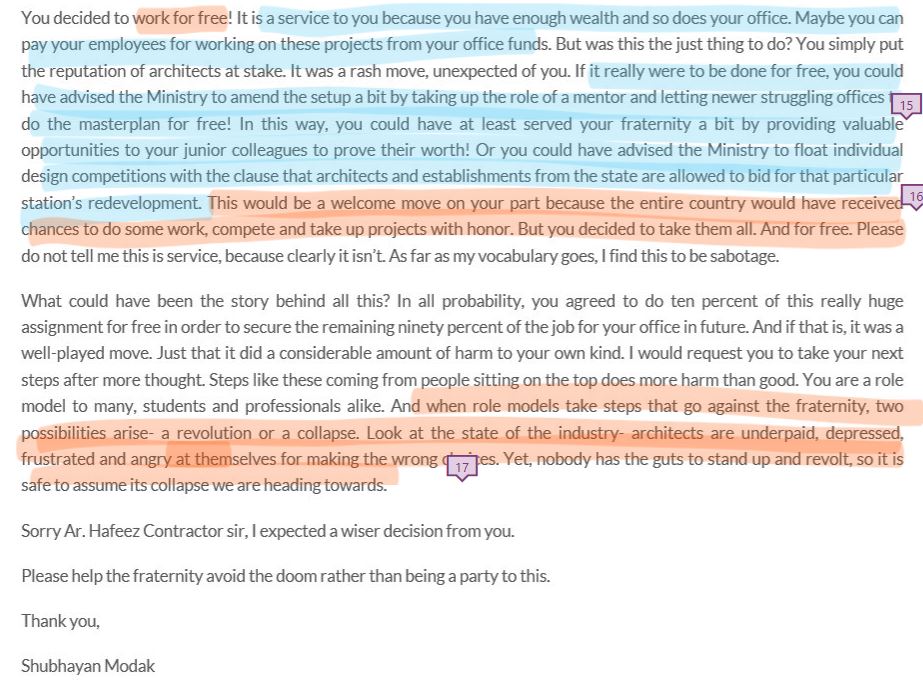
Towards the last leg of his letter, Mr. Modak advises on how things should have been dealt with. It reminds me of our Indian Cricket team. If they win a match, they are celebrated. If they lose, every tom, dick, and harry becomes an experienced critique. They get personal and underestimate the pressure on the team. They underestimate the situation and how different people deal with it. It is easy to advice on what others should do, specially when you are behind your computer screen sipping hot tea. Like society telling a girl on what she should wear? Because if she doesn’t then some people from society will be pissed.
As far as Mr. Modak’s idea of AHC advising the authorities is concerned, I find it farfetched. The kind of things you say to back your argument. An alternate reality in which your perspective is more practical. The pro-bono work was requested by the IRSDC and not the Architecture fraternity. Even then let me add the funny part. Mr. Modak wanted AHC to advice the ‘ministry’ to launch individual competition for development of railway stations. May be he didn’t know but it was already a competition! (Please tell me I am wrong here I must have missed something)
In the end, I would like to close by saying that, the idea that AHC ‘took it all. And for free’ is wrong. At least 30 architects nationwide have taken it up as per my week’s old knowledge, And on pro-bono basis. However I did not see people talk of these 30 or at least those other 3 architects who were mentioned in PTI’s report. Why? As a minimum requirement, every firm had to take up at least 6 stations, six times three are 18. Why will we only talk of 19 stations by one architect and not on 18 stations by rest three? I find the treatment biased and reaction unnecessary. Wrong people were targeted, all thanks to the media, words were twisted and a sorry ‘domed’ state was staged.
We as citizens need to get into the habit of doing our own research, because these kinds of journalist, the so called ‘unsung-courageous-heroes’, don’t take their job seriously.
Please do point out if there is fallacy in my argument, or there is something I should consider in regards with the incident.
* Views expressed in this article are those of the author and in no way represent the position of ArchitectureLive!
* The letter first appeared on Aakash’s blog: HERE.
 Aakash K Srivastav hails from Lucknow. He has a graduate degree in Bachelors of architecture (B.Arch). Parallel to his schooling and education, since childhood, he has been a part of programs which have laid importance on the various present-day problems. He has volunteered in flood hit areas of Uttar Pradesh and has also been a part of both ground and desk-staff of organizations such as S.A.D.E.D. He loves traveling and experiencing new cultures and has lived in seven (Indian) cities so far.
Aakash K Srivastav hails from Lucknow. He has a graduate degree in Bachelors of architecture (B.Arch). Parallel to his schooling and education, since childhood, he has been a part of programs which have laid importance on the various present-day problems. He has volunteered in flood hit areas of Uttar Pradesh and has also been a part of both ground and desk-staff of organizations such as S.A.D.E.D. He loves traveling and experiencing new cultures and has lived in seven (Indian) cities so far.
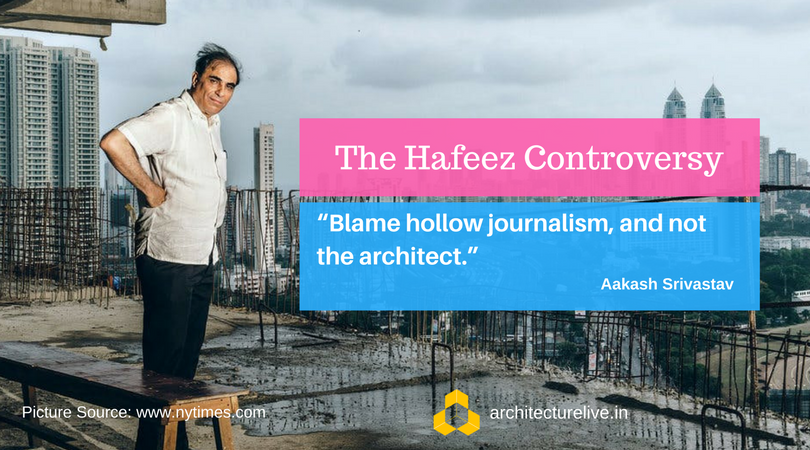






2 Responses
Thank you for writing this. I appreciate the effort to bring some facts to light. Bringing facts to light and presenting an alternative perspective could’ve been the standalone objective of this post rather than the eye for an eye manner in which this has been written. But then that’s completely your prerogative. We are marred by knee-jerk reactions to spiced up media reports in this information age. The society at large faces a grave crisis of not delving deeper into what is served to them as news. At the end I believe when the history of the fraternity would be written the 30 would find a place of respect and regard unlike what they have been currently made to look like.
PS: commendable on the part of the platform to publish this as well.
An absolute necessary reply, not to mention a fitting one. Thank you, Mr Srivastava.